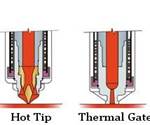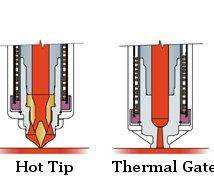The Valve Gate Advantage
Valve gate installations must be made to manufacturer specs to obtain the advantages necessary for competitive production of injection molded parts in today’s marketplace.
In today’s world of injection molded products, decisions on mold design and construction are often driven by initial price and delivery. This manner of mold acquisition can place the molded part in a position of not being at its long-term economic advantage for the company producing the first generation of parts, and not contributing a fair share to the bottom line profits for even short-run molds.
When a new generation of the same basic part is produced, molders often modify the existing tooling under the assumption that the procedure will keep production so well off economically, that competition will not get the new contract. On the contrary, a competitor with molds designed for long-term parts production, at the best ROI against the production run, will have an economic edge in rebidding, particularly if the same procedures are reflective of the total corporate outlook.
Factors to Consider When Choosing a System
Following are points to consider for both short-run and long-run injection molded plastic parts.
When considering the gating system to be used in a mold, all of the facets of an economic mold operation must be considered: initial total mold cost, mold trial cost, setup time, cycle time, maintenance, scrap, secondary operations, auxiliary equipment and part quality.
In the construction of a cold bushing, single-cavity mold with edge-gating of the part, added mold size is required to accommodate the runner and offset of the cavity from the sprue bushing. Well-designed systems will provide a low profile hot runner to move the resin to the offset for edge-gating with the least increase in mold size.
Reduced Mold Size Offsets Hot Runner Costs
The reduced mold size alone often offsets the hot runner’s initial cost and can permit the use of a press size to match the part requirements. By using a valve gate to the parting line, less resin is required per shot, which saves energy and reduces scrap (sprues) or the percentage of regrind used.
The economies of using a hot runner to replace mold offset are such that they should be considered for all parts above 50g with an expected production life above 150,000 parts. The larger the part, the lower the total number of parts may be due to the expensive mold base needed for a cold runner system, but with very low increases in the hot runner cost.
Advantages of Using a Sprue Bushing
The use of a sprue bushing to directly gate into a single-cavity mold provides several advantages in the construction and operation of the mold over the cold runner type. The mold base size is only dependent on the part requirements and will use the smallest press needed.
When using a cold sprue bushing, a sprue is created that must be removed, leaving a mark, which often must be removed by secondary operations if appearance or maximum height of the sprue remainder are part considerations. To prevent this, a hot sprue bushing is used, which often leaves an unacceptable mark, reduces the operating window and raises the level of internal part stress (warpage).
Use of a valve gate system will not produce a sprue, will reduce unacceptable marks, and maintain a good operating window while providing a part with the least possible stress. Most valve gate systems require a larger mold—both in the mold base footprint and height—since they must use a hot runner manifold to offset the valve gate operating system from mold centerline and must fit a manifold and the operating mechanism in the mold. Better designed systems will accomplish this with no increase in mold base footprint, and often without an increase in mold height because the valve gate is on the centerline of the mold and does not use an external operating mechanism.
Cold Runner System Dictates Larger Mold Sizes
When designing molds of multicavity layout using cold runner systems, the mold size often is increased to accommodate the runner, slides and mechanisms—and the cavity is more difficult to orientate for complex part shapes. The molding process operating window becomes very restricted and warpage control is dependent on part modification or long process times.
Three-plate mold construction is sometimes used to permit higher levels of cavitation, better cavity layout and automatic mold operation. Using a hot runner system with direct thermal gating in place of the traditional mold constructions will permit the utilization of the multicavity mold in a more economical form—smallest parting line surface per part, low mold height, better cycle time, least scrap and best automatic function.
Using a traditional valve gated hot runner will provide additional advantages in cycle times, reduced part stress and higher quality parts. However, new valve gated hot runner systems that cause no mold height increase and are less expensive can help alleviate the initial cost and mold height increases of traditional valve gated hot runners that reduce economical effectiveness.
To provide better mold delivery times, the hot runner order may be for the entire “A” half minus cavities. This spreads the workload to a larger facilities base, which can reduce mold construction time.
Hot Runner System Reduces Cost, Time and Waste
When the above summaries are applied to the acquisition of molds, it should be apparent that a hot runner system can significantly reduce initial cost, tool construction time, and operating expenses of trials, setup, cycle time, maintenance, scrap and secondary operations—and with an efficient valve gate system—no additional equipment is necessary. The hot runner will provide the high consistency of part quality demanded by most applications.
Mold designs using hot runner thermal gated systems and valve gate systems are often specified to provide the utmost in high-performance molding. They will produce very consistent shot-to-shot repeatability, faster cycle times, good automatic mold operation and better part quality.
A well-designed system of hot runner valve gates will normally out-perform other systems—both thermal and valve gate alike. Such a system uses less mold height, less power, and no external control or auxiliary power systems. The bottom line is that a hot runner system will provide overall advantages that should be explored in nearly any injection mold acquisition.
Valve gate installations should be made to the specs issued by their manufacturer to obtain the advantages necessary for competitive production of injection molded parts in today’s marketplace. The valve gate advantages over the thermal gate systems stem from the very straightforward, sturdy construction of all components, which is derived from a basic design concept of the least number of parts to provide the best gate flow/control situation.
Related Content
6 Ways to Optimize High-Feed Milling
High-feed milling can significantly outweigh potential reliability challenges. Consider these six strategies in order to make high-feed milling successful for your business.
Read MoreForces and Calculations Are Key to Sizing Core Pull Hydraulic Cylinders
To select the correct cylinder, consider both set and pull stroke positions and then calculate forces.
Read MoreHands-on Workshop Teaches Mold Maintenance Process
Intensive workshop teaches the process of mold maintenance to help put an end to the firefighting culture of many toolrooms.
Read MoreMoldmakers Deserve a Total Production Solution
Stability, spindle speed and software are essential consideration for your moldmaking machine tool.
Read MoreRead Next
Why Choose a Valve-Gated Hot Runner?
Moldmakers need to be aware of how different gating technology can affect their customers when designing a hot runner system into a mold.
Read MoreReasons to Use Fiber Lasers for Mold Cleaning
Fiber lasers offer a simplicity, speed, control and portability, minimizing mold cleaning risks.
Read MoreAre You a Moldmaker Considering 3D Printing? Consider the 3D Printing Workshop at NPE2024
Presentations will cover 3D printing for mold tooling, material innovation, product development, bridge production and full-scale, high-volume additive manufacturing.
Read More








.jpg;maxWidth=300;quality=90)






_300x250 1.png;maxWidth=300;quality=90)














